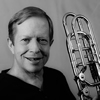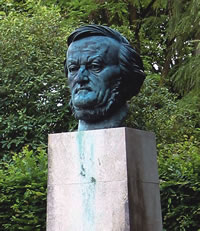Allegro
‘The artwork of the future’
Volume 113, No. 8September, 2013

Steve Norell
Having had the opportunity to play Wagner’s operas at the Metropolitan Opera is the fulfillment of a lifelong dream. My appreciation has only grown over the years, as I’ve been privileged to play most of this repertoire many times. On the back of the last page of the first trumpet part of “Die Walküre,” there is a list of who conducted the early year performances. Gustav Mahler was listed as conducting the 1907-08 season!
In 1849, Wagner wrote an article entitled “The Artwork of the Future” in which he described a vision of opera as “Gesamtkunstwerk” (“total work of art”). The various arts such as music, song, dance, poetry, visual arts and stagecraft would be unified. Wagner had his own opera house built, the Bayreuth Festspielhaus, which embodied many novel design features. Performances there were the first to have the concert space dark except for the stage. Only the front of the orchestra pit was visible to the audience as most of the pit went down under the stage with the sound coming through grates above. This made the balance much easier for soloists in the loud tutti sections, but very loud and hot for musicians in the pit. Wagner’s masterpiece “Der Ring des Nibelungen” (commonly known as the Ring Cycle) was first performed here. The Ring Cycle consists of one story spread over four different operas: “Das Rheingold,” “Die Walküre,” “Siegfried” and “Götterdämmerung.” The complete Ring Cycle lasts approximately 18 hours – without intermissions.
Whereas the Ring Cycle must be considered one of the ultimate music dramas, I would consider other Wagner works to be somewhat more vocally lyric. “Die Mestersinger” is his only comic work and the second act is sheer comic genius. Hearing Johan Botha sing the prize song from the third act is one of the most beautiful things I’ve ever heard. “Tristan and Isolde” (which was written between the second and third acts of “Siegfried”) is the ultimate love story where Wagner’s chromatic writing challenges unresolved tonality. Early Wagner works such as “The Flying Dutchman,” “Lohengrin” and “Tannhäuser” seem to me to be somewhat fresher in style, and every “Parsifal” performance is a moving experience for me.

Sculpture of Wagner on the grounds of the Festspielhaus in Bayreuth, Germany. Photo courtesy: Itig Journal
Wagner writes for the full chorus magnificently in all his operas. (In the Ring Cycle, the chorus only enters in “Götterdämmerung.”) His writing for all orchestral instruments challenges their limitations and he invents other instruments to satisfy his musical needs. Even though Wagner is known for loud intensity, I’m always amazed by the transparency of the most delicate moments. Often times a delicate chorale doesn’t have a voice doubled and if a voice doesn’t speak, the harmony is changed.
My first Ring performances were with Erich Leinsdorf, who was also conducting “Die Frau ohne Schatten” by Strauss that season. I remember that Maestro Leinsdorf commented on the difference in performing works by the two composers. Sometimes the virtuosic wave of a fast technical Strauss passage will create the composer’s desired result without every note being perfect. Wagner is more literal and in that way more demanding.
What a pleasure it is listening to my colleagues play their solos across the orchestra pit, but the greatest strength of our orchestra is the depth of our string section. What a sound! These musicians have the greatest challenge in playing this repertoire. It is not just the technical challenge of mastering so many notes, but the physical endurance of playing nonstop for such a long period of time. With two performances on Saturdays, a string player’s nightmare is a doubleheader consisting of a long Wagner followed by a Mozart that requires almost nonstop playing.
While the Met’s supertitles (which have been used for about 20 years) make many operas more accessible than they have ever been, audiences at Met performances will often be highly influenced by the language that’s being sung. If you go into the lobby of the auditorium during the Wagner intermission, it’s not unusual to hear mostly German. For someone who has not previously attended an opera, I would recommend something more accessible like “La Bohème” or “The Magic Flute.” Save the Wagner until you know what you’re getting into.
At the end of the 1988-89 Met season, we played the Otto Schenk production of the entire Ring within one week, which was the first time it had been done at the Met in 100 years. Tickets were sold for complete cycles and you saw the same faces in the same seats as we worked through the Cycle. The applause for the orchestra increased over the course of the week and by the Saturday night “Götterdämmerung” finale, the audience cheering for the orchestra seemed like what one would encounter in a wild athletic event. This is a memory that I will carry with me always.
Steve Norrell plays bass trombone with the Metropolitan Opera Orchestra.
